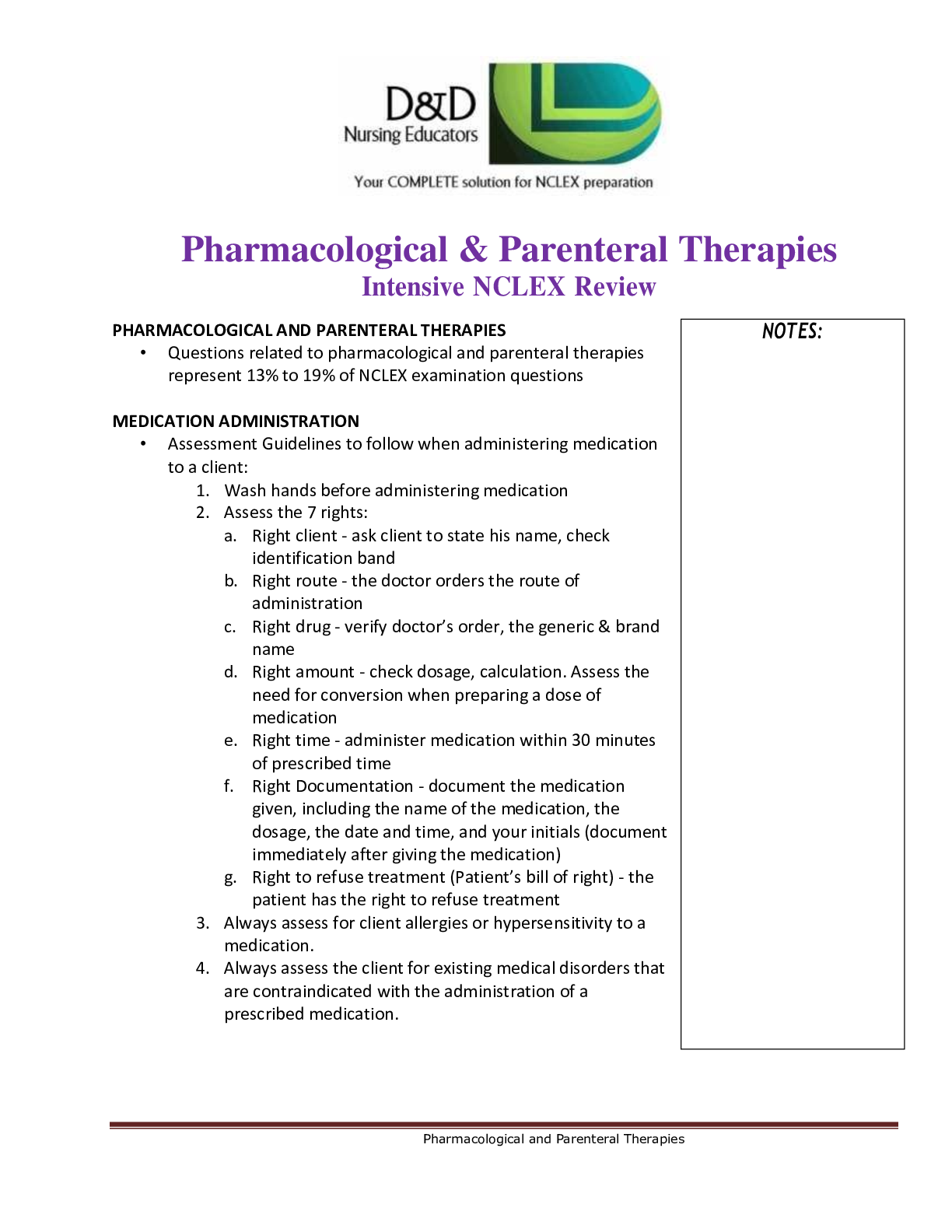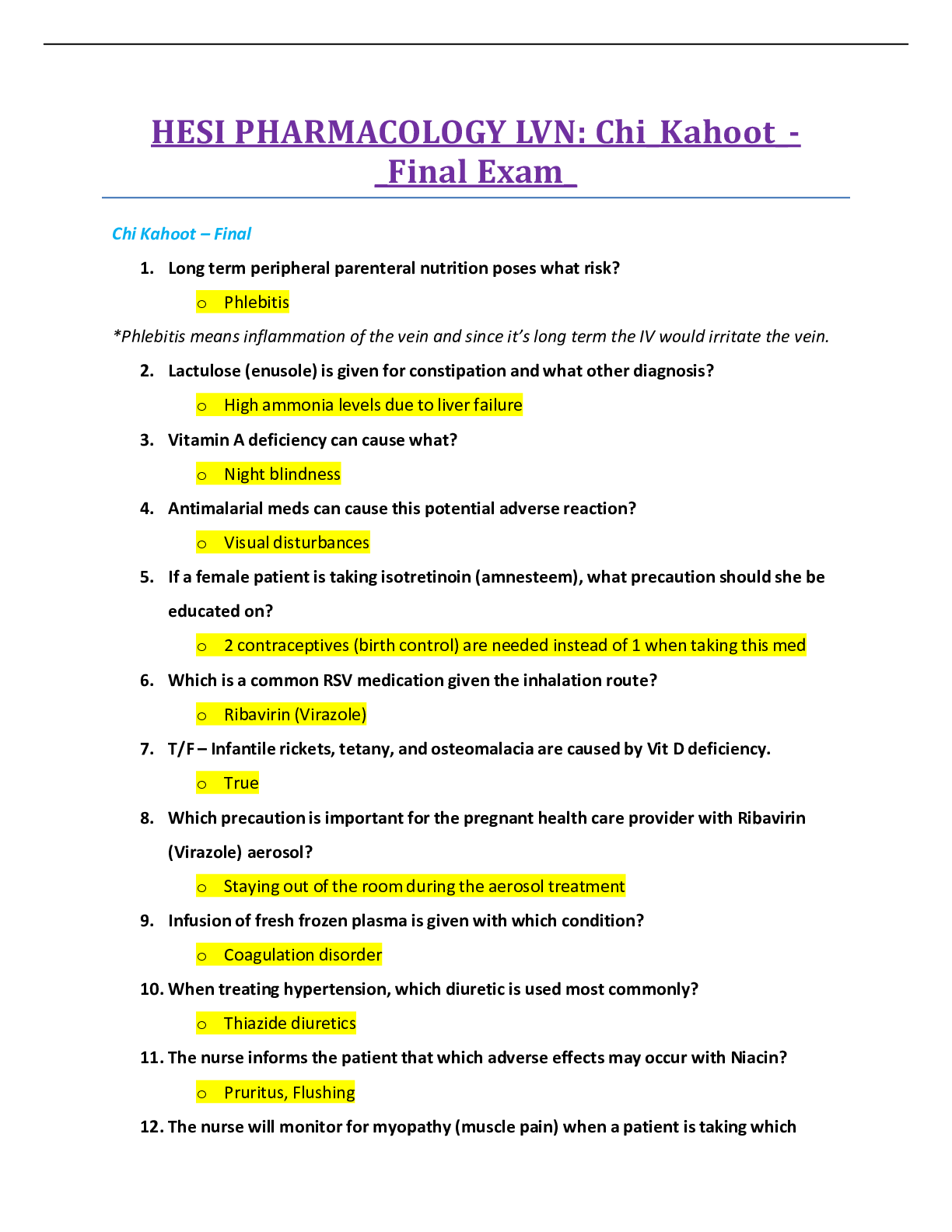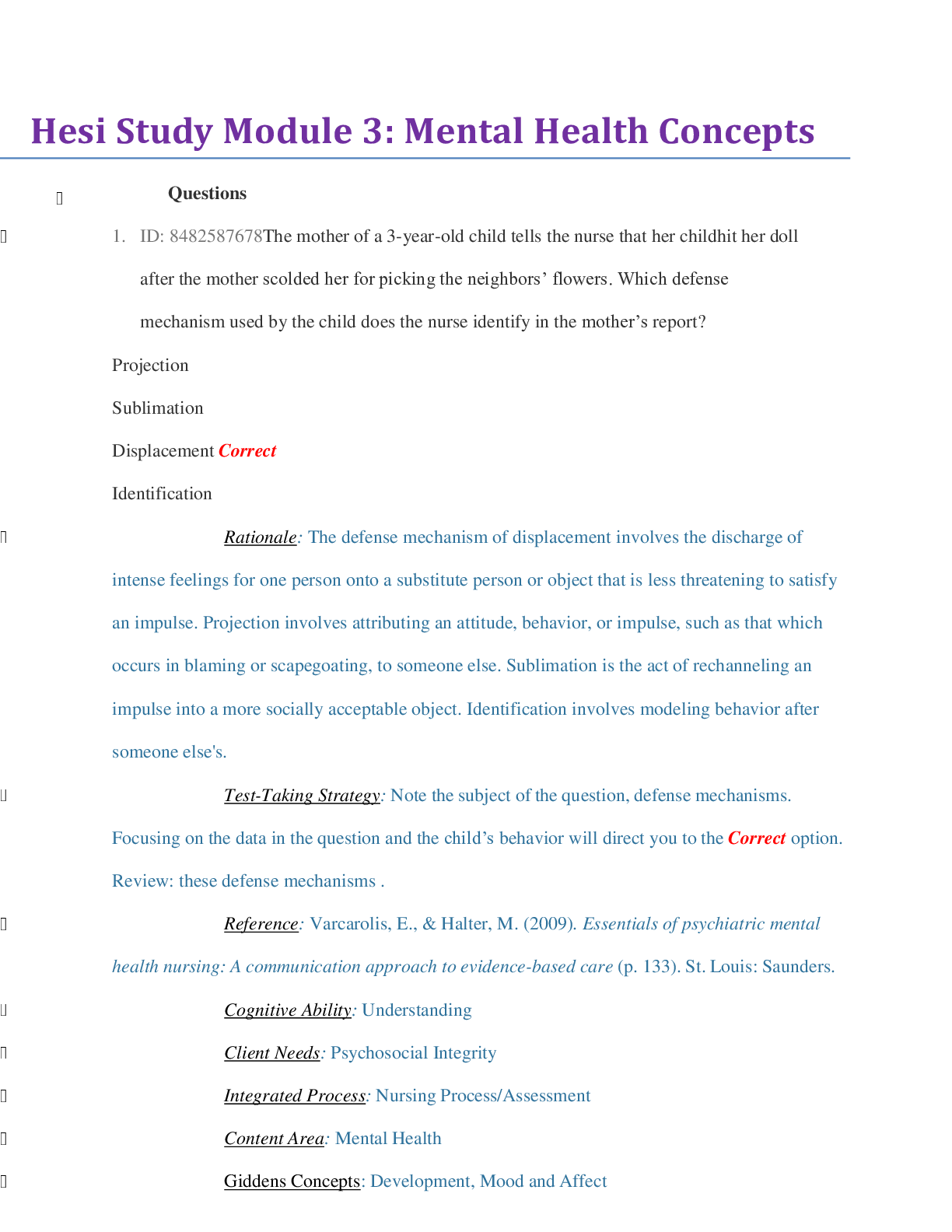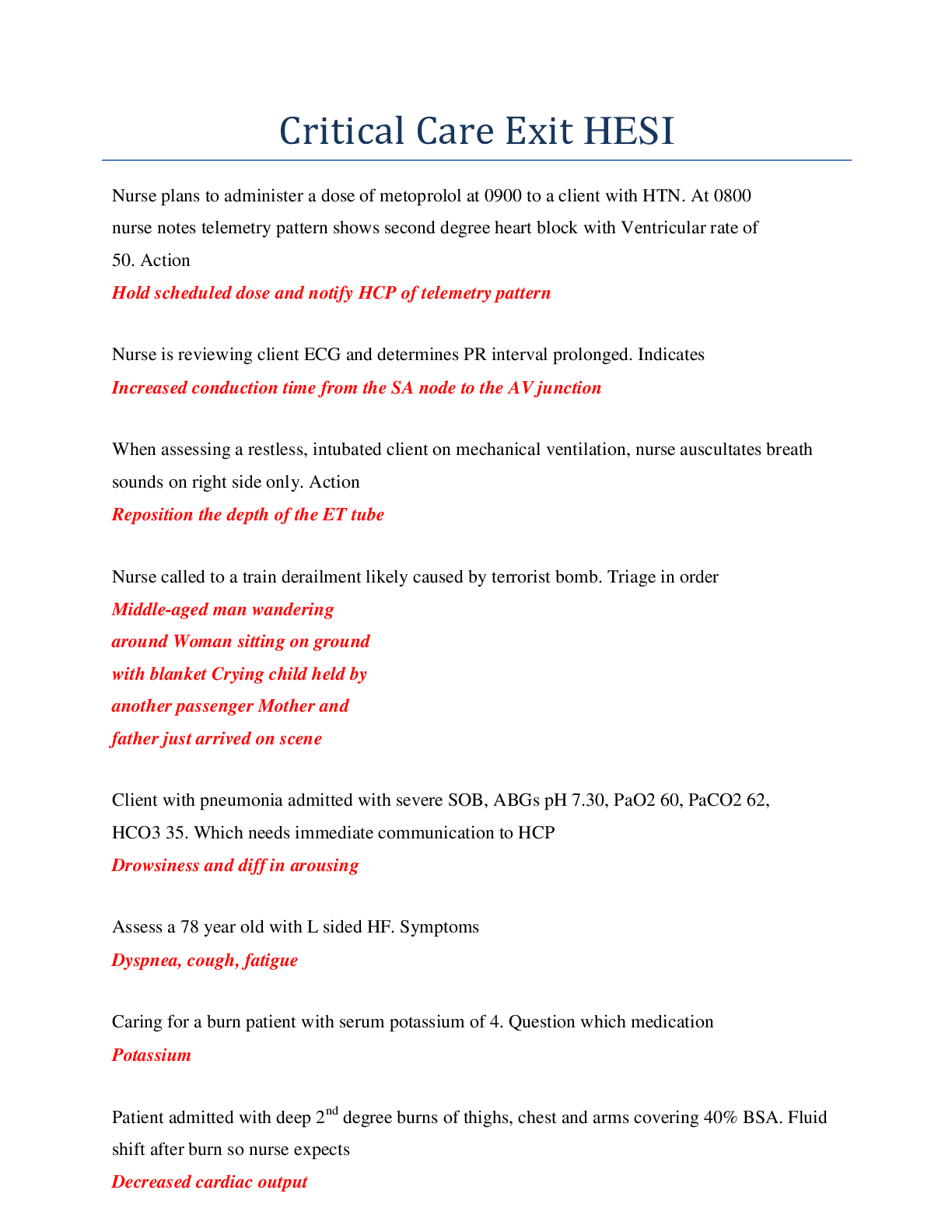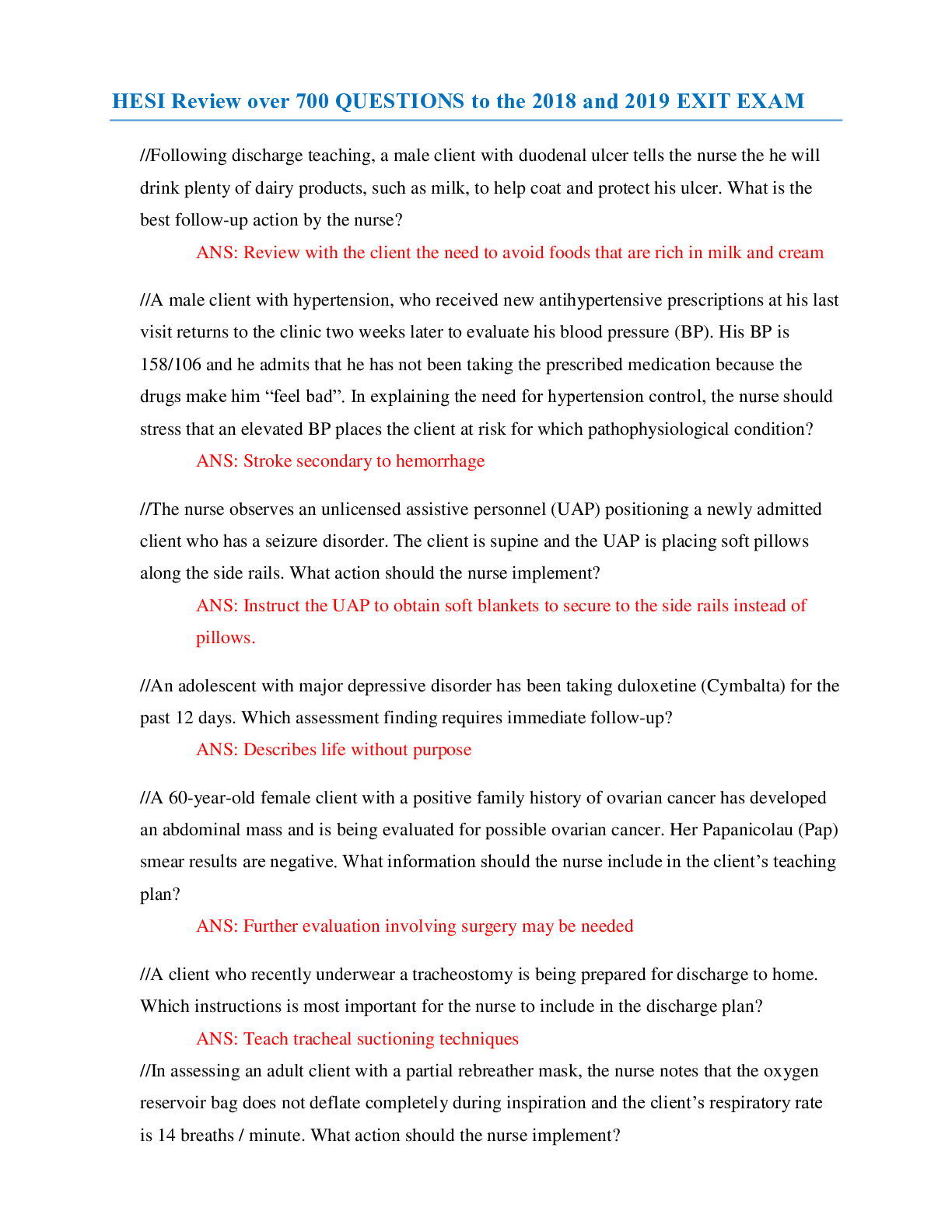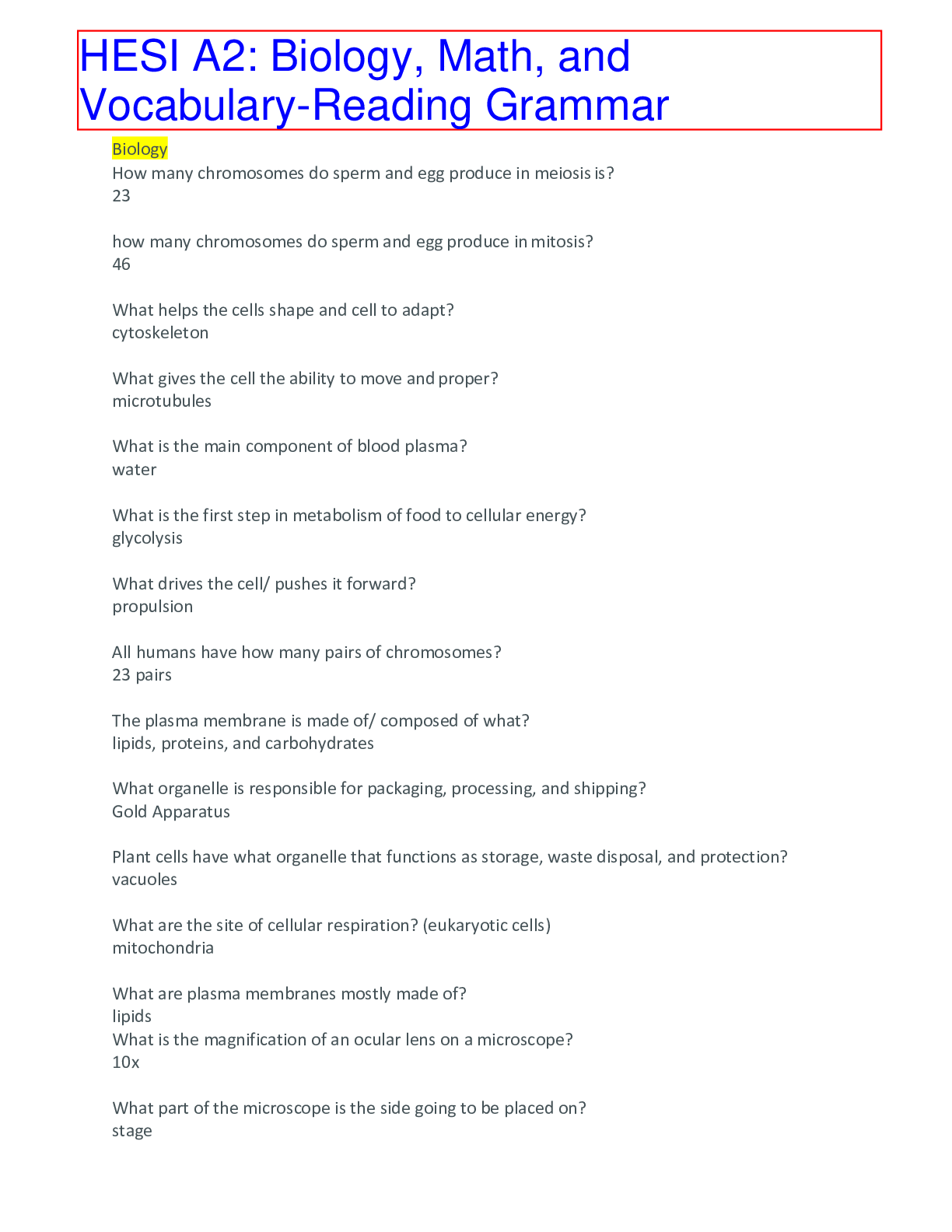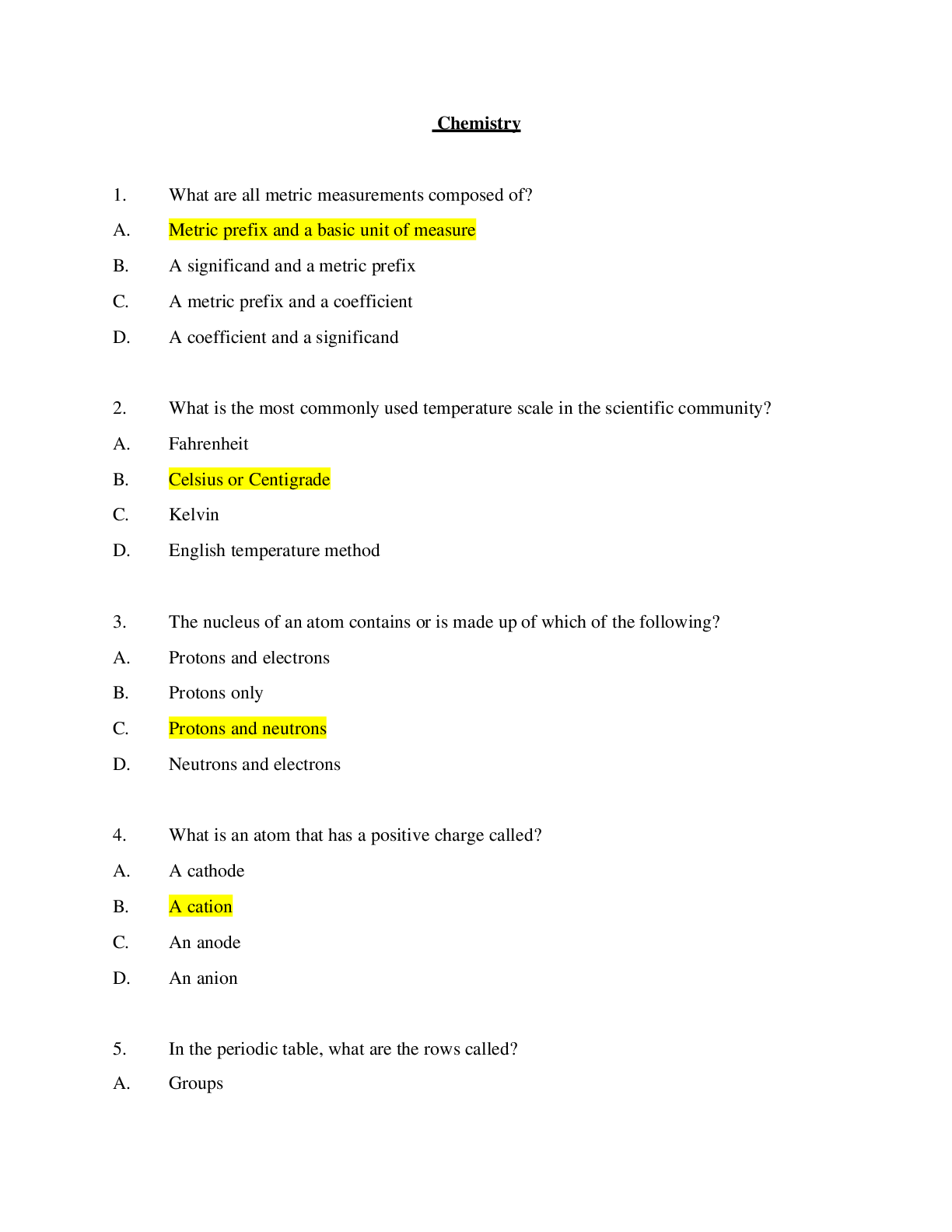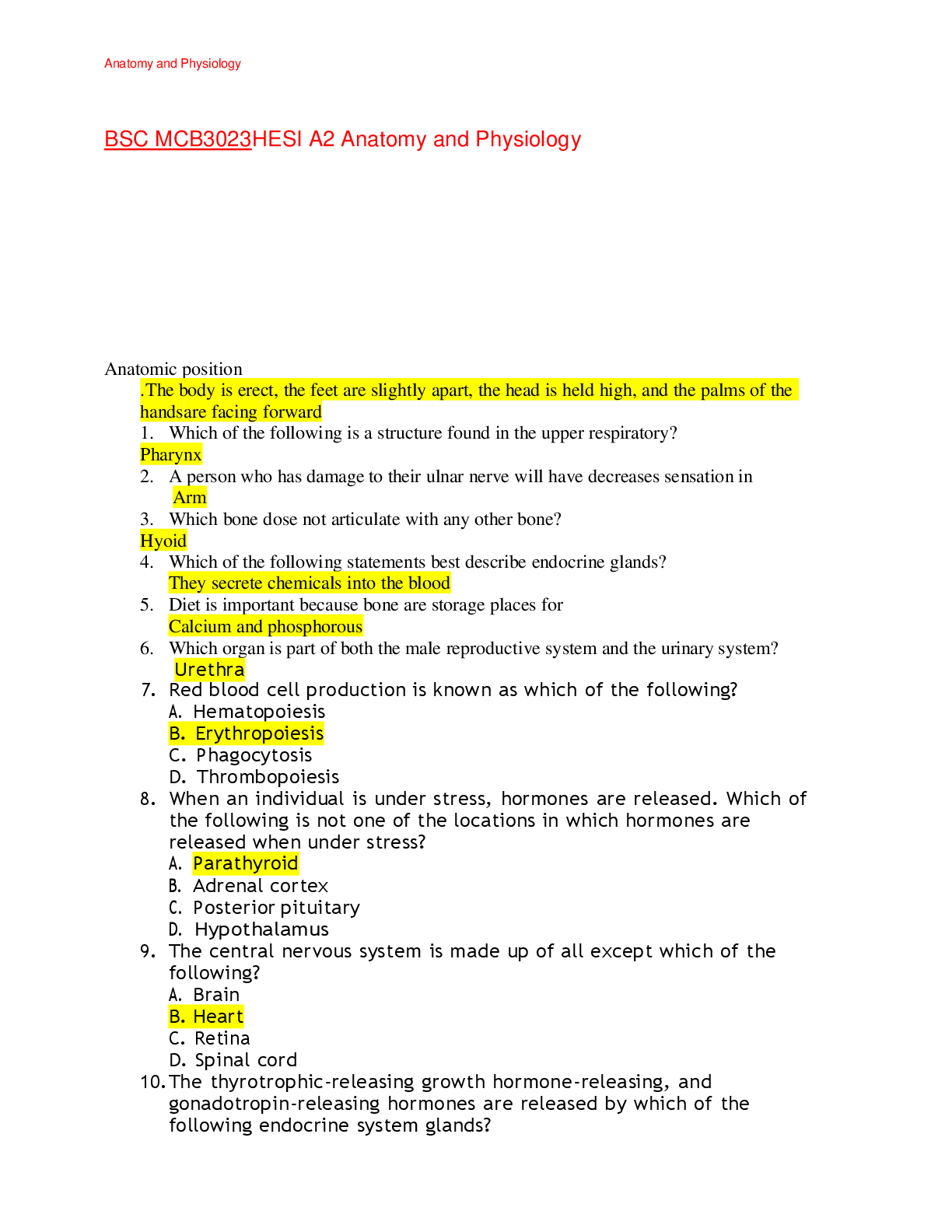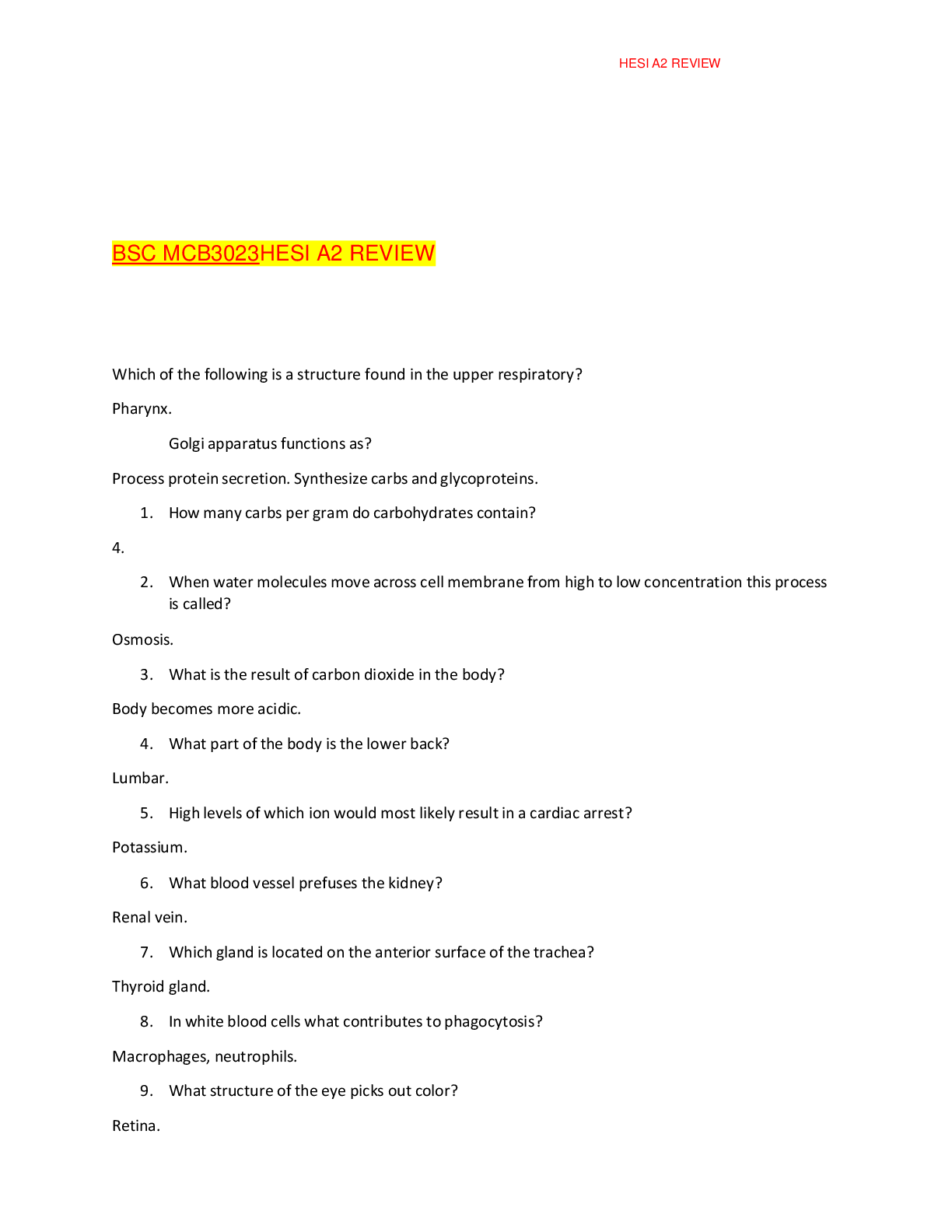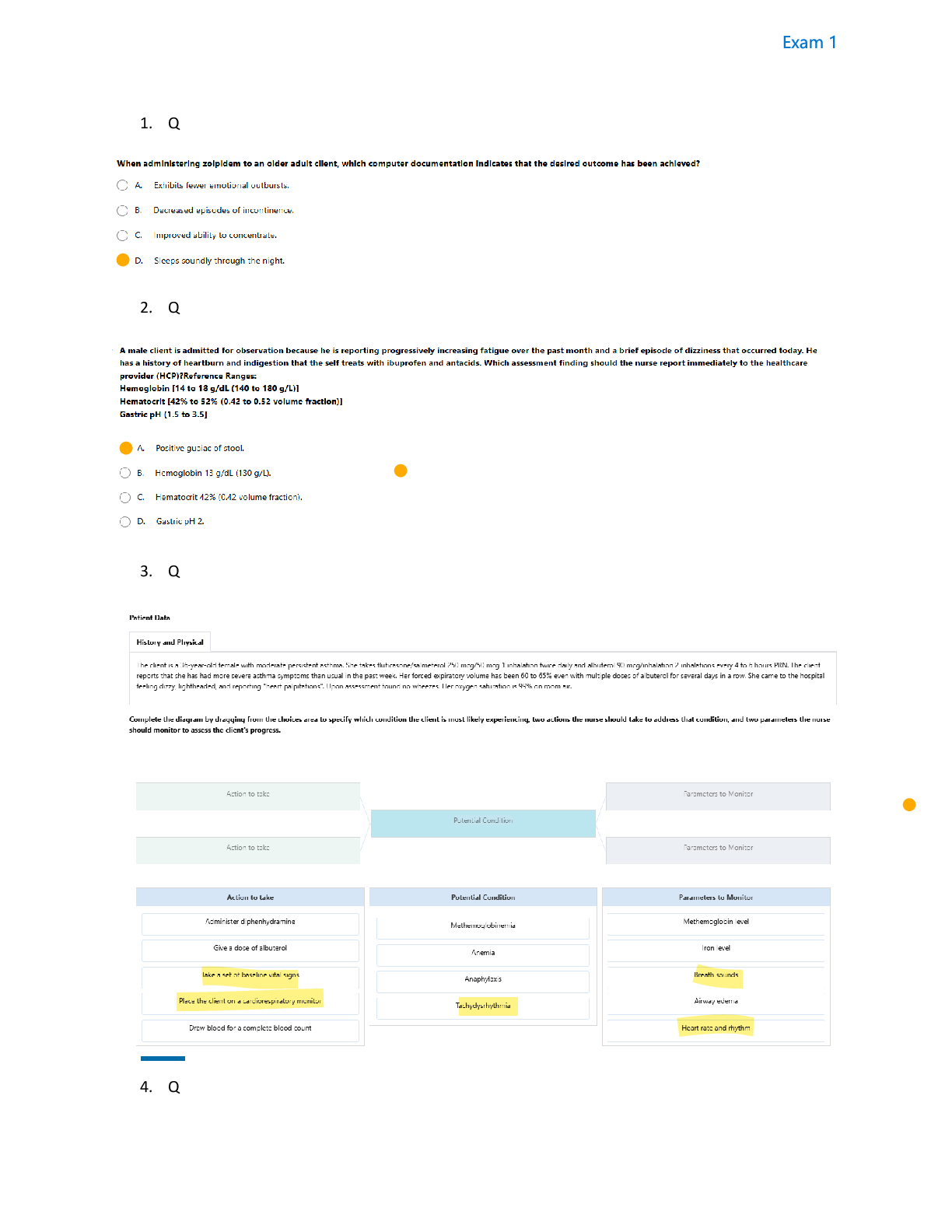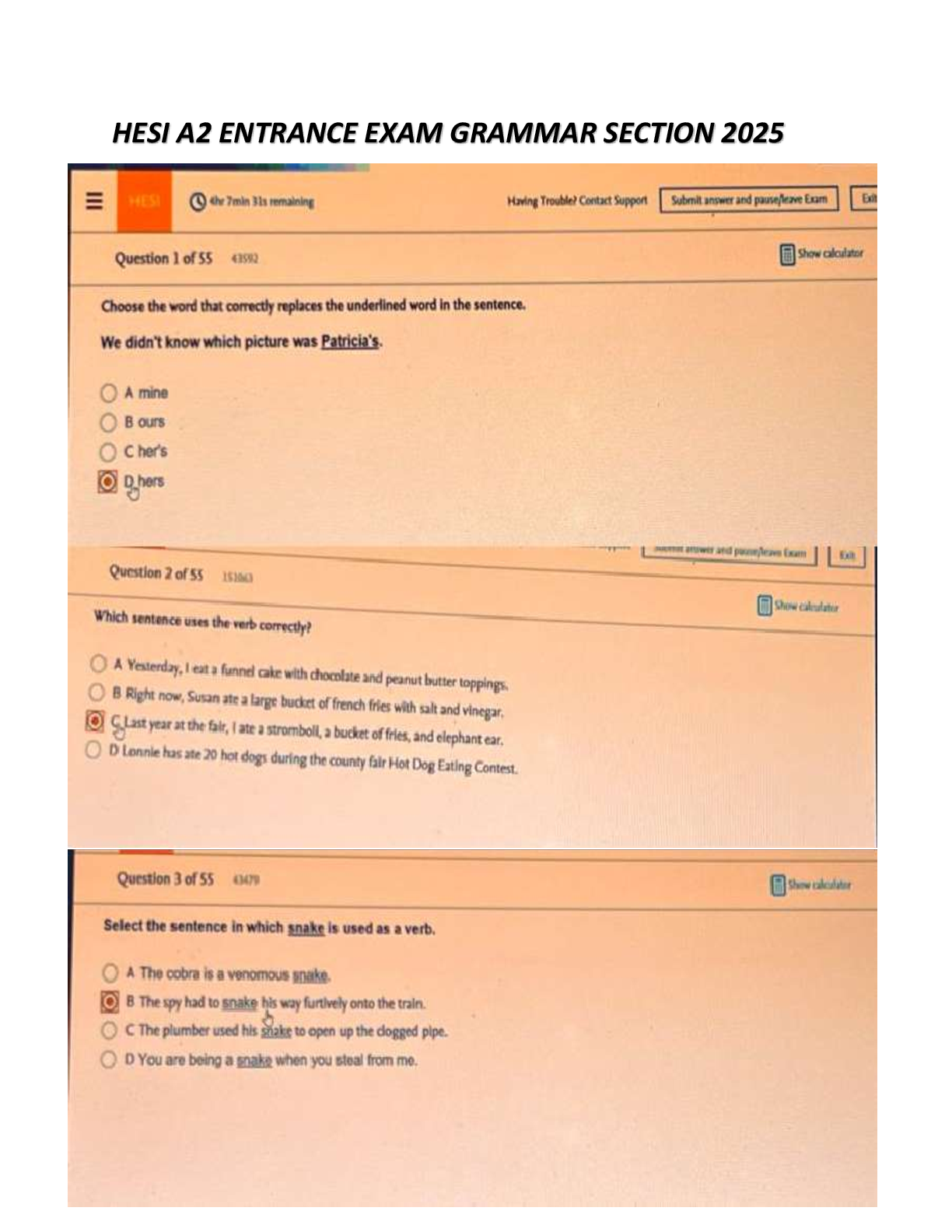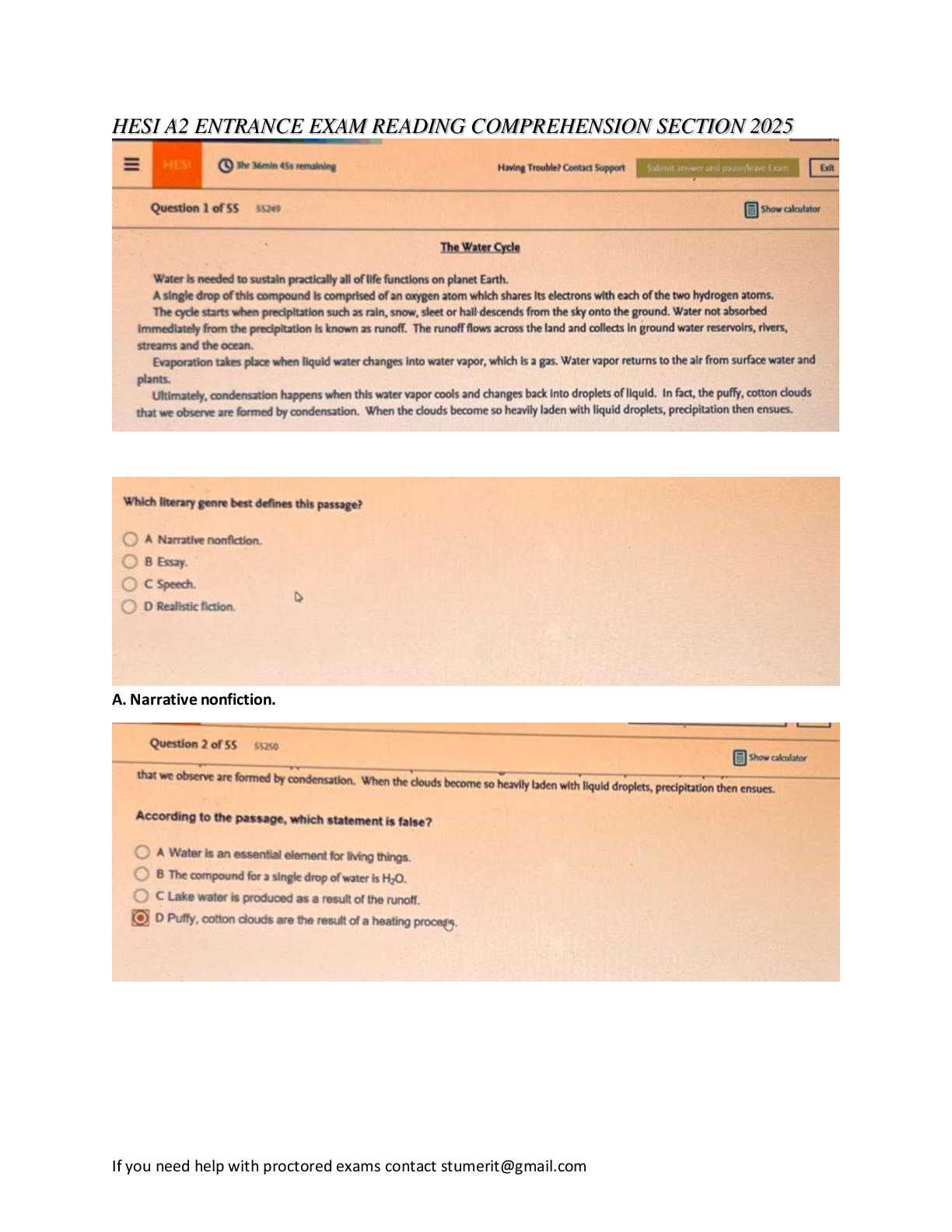*NURSING > HESI > Pharmacology HESI Exit Evolve. 100+ common Questions and Answers. 27 pages. Includes Explanations. (All)
Pharmacology HESI Exit Evolve. 100+ common Questions and Answers. 27 pages. Includes Explanations.
Document Content and Description Below
HERE ARE SAMPLE QUESTIONS AND ANSWERS A client receiving a continuous infusion of heparin IV starts to hemorrhage from an arterial access site. Which medication should the nurse anticipate a ... dministering to prevent further heparin-induced hemorrhaging? Protamine sulfate Protamine sulfate is the antagonist for heparin and is given for episodes of acute hemorrhage. A chemotherapeutic regimen with doxorubicin HCl is being planned for a client recently diagnosed with cancer. What diagnostic test results should the nurse review prior to initiating this treatment? EKG Baseline cardiac function studies are required to monitor the irreversible cardiotoxic effects of doxorubicin When providing client teaching about the administration of methylphenidate (Ritalin) to a parent of a child diagnosed with ADHD, which instruction should the nurse include in the teaching plan? Offer the child the medication with breakfast and after the child eats lunch. Administering the medication at breakfast and after lunch provides the correct spacing of the doses to maximize the child's attention span and helps prevent the appetite suppression associated with the drug. Doses should be spaced at 6-hour intervals A client is receiving acyclovir sodium IV for a severe herpes simplex infection. Which intervention should the nurse implement during this drug therapy? Increase daily fluids to 2000 to 4000 mL/day. Increasing fluid intake during treatment prevents precipitation of the drug in the renal tubules, which could lead to obstructive problems that impair kidney function. Acute glomerulonephritis is a possible complication of acyclovir sodium therapy The health care provider prescribes the anticonvulsant carbamazepine for an adolescent client with a seizure disorder. The nurse should instruct the client to notify the health care provider if which condition occurs? Develops a sore throat Blood dyscrasias (aplastic anemia, leukopenia, anemia, and thrombocytopenia) can be an adverse effect of carbamazepine. Flulike symptoms, such as pallor, fatigue, sore throat, and fever, are indications of such dyscrasias.The health care provider prescribes cisplatin to be administered in 5% dextrose and 0.45% normal saline with mannitol added. Which assessment parameters would be most helpful to the nurse in evaluating the effectiveness of the therapy? Urine output The effectiveness of the diuresis is best measured by urine output. Mannitol, an osmotic diuretic, is given during cisplatin therapy to promote diuresis and reduce the risk of nephrotoxicity and ototoxicity associated with this chemotherapeutic agent Methylphenidate is prescribed for daily administration to a 10-yearold child with attentiondeficit/hyperactivity disorder (ADHD). In preparing a teaching plan for the parents of this child newly diagnosed with ADHD, which instruction is most important for the nurse to provide to the parents? Administer the medication in the morning before the child goes to school. Methylphenidate is a central nervous system (CNS) stimulant. To be most effective in affecting the child's behavior, the dose of the drug should be administered in the morning before the child goes to school. Drug holidays are often prescribed to assess the child's degree of recovery; however, such interruptions are not conducted in the early phase of treatment and are usually implemented when side effects occur over a period of time. The nurse is scheduling a client's antibiotic peak and trough levels with the laboratory personnel. What is the best schedule for drawing the trough level? Instruct the laboratory to draw the trough immediately before the next scheduled dose. The best time to draw a trough is the closest time to the next administration. A lidocaine IV infusion at 4 mg/min via infusion pump is prescribed for a client having premature ventricular contractions (PVCs). The available premixed infusion contains 2 mg/mL of D5W. How many milliliters per hour should the nurse program the pump to deliver to this client? 120 Rationale: 120 mL/hr = 1 mL/2 mg × 4 mg/min × 60 min/hr. A client with a dislocated shoulder is being prepared for a closed manual reduction using conscious sedation. Which medication should the nurse explain as a sedative used during the procedure? Midazolam IV Conscious sedation uses sedative-hypnotics that do not compromise the airway, so IV midazolam, a short-duration benzodiazepine sedative, provides conscious sedation with local and regional anesthesia and has an amnestic effect.Inhaled nitrous oxide:- a weak anesthetic and is rarely used alone. Ketamine IM:- causes profound analgesia that causes a client to appear catatonic and amnestic. Fentanyl:- is an opioid more commonly used as an analgesic during anesthesia, whereas droperidol is a skeletal muscle anesthetic agent used to reduce spasticity to ensure a smooth induction under general anesthesia and requires intubation and ventilation during its onset and duration. During therapy with isoniazid, it is most important for the nurse to monitor which laboratory value closely? Liver enzyme levels The client receiving isoniazid is at risk for the development of hepatitis; therefore, liver function test results should be monitored carefully during drug therapy. The health care provider prescribes oral contraceptives for a client who wants to prevent pregnancy. Which information is the most important for the nurse to provide to this client? Take one pill at the same time every day until all the pills are gone. To maintain adequate hormonal levels for contraception and enhance compliance, oral contraceptives should be taken at the same time each day. There is no strong pharmacokinetic evidence that shows a relationship between the category of broad-spectrum antibiotic use and altered hormone levels in oral contraceptive users. Abstinence is the best method to prevent pregnancy during the first cycle. If a client misses two pills during the first week, the client should take two pills a day for 2 days and finish the package while using a backup method of birth control until her next menstrual cycle. A female client with trichomoniasis (Trichomonas vaginalis) receives a prescription for metronidazole. Which instruction is most important for the nurse to include in this client's teaching plan? Avoid alcohol consumption Clients should be instructed to avoid alcohol and products containing alcohol while taking metronidazole because of the possibility of a disulfiram-like reaction. Complete the medication regimen helps prevent the development of metronidazole-resistant T. vaginalis. To prevent reinfection, clients should abstain from sexual contact or use a barrier contraceptive while taking metronidazole, and their partner(s) should be treated concurrently.In addition to nitrate therapy, a client is receiving nifedipine, 10 mg PO every 6 hours. The nurse should plan to observe for which common side effect of this treatment regimen? Hypotension Nifedipine reduces peripheral vascular resistance and nitrates produce vasodilation, so concurrent use of nitrates with nifedipine can cause hypotension with the initial administration of these agents. A client with Tourette syndrome takes haloperidol to control tics and vocalizations. The client has become increasingly drowsy over the past 2 days and reports becoming dizzy when changing from a supine to sitting position. Which action should the nurse take? Assess for poor skin turgor, sunken eyeballs, and concentrated urine output. Because haloperidol causes CNS effects of sedation and decreased thirst, the nurse should assess for signs of dehydration. Although sedation may occur with haloperidol administration, this side effect may signal an adverse CNS reaction. A client with HIV who was recently diagnosed with tuberculosis (TB) asks the nurse, "Why do I need to take all of these medications for TB?" What information should the nurse provide? Multiple drugs prevent the development of resistant organisms. A multidrug regimen is prescribed for a client with HIV and TB to prevent the development of resistance of the tubercle bacilli. Although antitubercular medications can inhibit some antiretrovirals, a multidrug regimen is needed to inhibit the proliferation of the virulent tubercle bacilli. The duration of antitubercular therapy is typically 6 to 9 months and is not shortened by the use of multiple medications. A client who is receiving HIV and TB therapy is at an increased risk of adverse reactions because of the complex medication regimens and complications secondary to immunosuppression. A client is taking famotidine. Which client statement should the nurse further assess because it may indicate that the client is experiencing a side effect of this drug? "I seem to be having difficulty thinking clearly." A common side effect of of famotidine is confusion. A 3-year-old boy is admitted to the emergency department after ingesting an unknown amount of phenobarbital elixir prescribed for his brother's Take the child's vital signs. Phenobarbital causes respiratory depression, so the priority intervention is assessment of vital signs.seizure disorder. Which nursing intervention should the nurse implement first? The nurse is preparing to administer amphotericin B IV to a client. What laboratory data is most important for the nurse to assess before initiating an IV infusion of this medication? Serum potassium level The nurse should obtain baseline potassium levels prior to beginning drug therapy because amphotericin B changes cellular permeability, allowing potassium to escape from the cell, which could lead to a decrease in the serum potassium level and severe hypokalemia. Amoxicillin, 500 mg PO every 8 hours, is prescribed for a client with an infection. The drug is available in a suspension of 125 mg/5 mL. How many milliliters should the nurse administer with each dose? 20 Rationale: 500 mg/x mL = 125 mg/5 mL 125x = 2500 x = 20 mL A client who is experiencing an acute attack of gouty arthritis is prescribed colchicine USP, 1 mg PO daily. Which information is most important for the nurse to provide the client? Report any vomiting to the clinic. The client should be instructed to report signs of colchicine toxicity, such as nausea, diarrhea, vomiting, and/or abdominal pain, to the health care provider. Food inhibits the absorption of colchicine when ingested concurrently. Limited fluid intake decreases the excretion of the uric acid crystals, which contributes to painful attacks. Typically, a client should remain on a daily dose of colchicine to decrease the number and severity of acute attacks, so stopping the medication after the pain resolves is not indicated. During administration of theophylline, the nurse should monitor for signs of toxicity. Which symptom would cause the nurse to suspect theophylline toxicity? Restlessness is a sign of theophylline intoxication. Other signs of toxicity are anorexia, nausea, vomiting, insomnia, tachycardia, arrhythmias, and seizures. Options A, B, and D are common side effects of antihistamines but do not indicate theophylline intoxication. A female client who has started long-term corticosteroid therapy tells the nurse that she is careful to take her daily dose at bedtime with a snack of crackers and milk. Which is the best response by the Advise the client to take the medication in the morning, rather than at bedtime. Daily doses of long-term corticosteroid therapy should be administered in the morning to coincide with the body's normal secretion of cortisol. Clients receiving long-term corticosteroids need to increase their intake of calcium,nurse? which generally means an increase in dairy products. Corticosteroids can often cause gastrointestinal distress and should be administered with meals. The client has established a safe routine by taking the medication with a snack, but the routine will be more effective if done in the morning. A client with acute lymphocytic leukemia is to begin chemotherapy today. The health care provider's prescription specifies that ondansetron is to be administered IV 30 minutes prior to the infusion of cisplatin. What is the rationale for administering Zofran prior to the chemotherapy induction? Reduction or elimination of nausea and vomiting. Ondansetron is a type 3 receptor (5-HT3) antagonist that is recognized for improved control of acute nausea and vomiting associated with chemotherapy. 5-HT3 antagonists are most effective when administered IV prior to the induction of the chemotherapeutic agent(s) The health care provider prescribes the H2 antagonist famotidine, 20 mg PO in the morning and at bedtime. Which statement regarding the action of H2 antagonists offers the correct rationale for administering the medication at bedtime? Hydrochloric acid secreted during the night is blocked. H2 antagonists act on the parietal cells to inhibit gastric secretion. Some gastric secretion occurs all the time, even when the stomach is empty, unless medications are taken to inhibit this action. A client is receiving pyridostigmine bromide to control the symptoms of myasthenia gravis. Which client behavior would indicate that the drug therapy is effective? Clear speech is the result of increased muscle strength. Muscle weakness characteristic of myasthenia gravis often first appears in the muscles of the neck and face. The nurse has completed diabetic teaching for a client who has been newly diagnosed with diabetes mellitus. Which statement by this client would indicate to the nurse that further teaching is needed? "When I exercise, I should plan to increase my insulin dosage." Exercise helps facilitate the entry of glucose into the cell, so increasing insulin doses with exercise would place the client at high risk for a hypoglycemic reaction. A client who is HIV-positive is receiving epoetin alfa for the management of anemia secondary to zidovudine (AZT) therapy. Which Hematocrit (HCT) of 58% should be reported to the health care provider immediately because of the likelihood of a hypertensive crisis andlaboratory finding is most important for the nurse to report to the health care provider? because seizure activity increases with an increase in HCT of more than 4 points, or an HCT above 36%. Epoetin alfa stimulates erythropoiesis (production of red blood cells), thereby decreasing the need for blood transfusions. Uncontrolled hypertension can occur if erythropoietin levels are too high. A female client is receiving tetracycline for acne. Which client teaching should the nurse include? Oral contraceptives may not be effective. Certain antibiotics, such as tetracycline, decrease the effectiveness of oral contraceptives. A client with metastatic cancer who has been receiving fentanyl for several weeks reports to the nurse that the medication is not effectively controlling the pain. Which intervention should the nurse initiate? Notify the health care provider of the need to increase the dose. Clients can develop a tolerance to the analgesic effect of opioids and may require an increased dose for effective long-term pain relief. The client is not exhibiting indications of dependence, withdrawal, or toxicity. A female client is receiving tamoxifen following surgery for breast cancer. She reports the onset of hot flashes to the nurse. Which intervention should the nurse implement? Instruct the client that hot flashes are a side effect that often occurs with the use of this medication. Tamoxifen is an estrogen receptor blocker used to treat breast carcinoma. Hot flashes are a common side effect. If the hot flashes become bothersome, the client can be instructed in measures to reduce the discomfort. Which instructions should the nurse provide to an adolescent female client who is initiating treatment with isotretinoin for acne vulgaris? (Select all that apply.) "Notify the health care provider immediately if you think you are pregnant." "If you begin crying more than usual and feel sad, stop the drug and call the health care provider." "Before, during, and after therapy, two effective forms of birth control must be used at the same time." Isotretinoin has been found to cause pregnancy category D drug-related birth defects, premature births, and fetal death (A), which necessitates the use of effective birth control methods before, during, and after therapy (F). Isotretinoin isassociated with sadness (E), depression, suicidal ideations, and other serious mental health problems. Which instruction should the nurse include in the teaching plan for a client who is receiving phenytoin for seizure control? Brush and floss teeth daily. Brushing and flossing the teeth daily prevent gingival hyperplasia (gum disease) that is common with long-term phenytoin therapy. A client is being discharged with a prescription for sulfasalazine to treat ulcerative colitis. Which instruction should the nurse provide to this client prior to discharge? Drink at least eight glasses of fluid a day. Adequate hydration is important for all sulfa drugs because they can crystallize in the urine. If possible, the drug should be taken after eating to provide longer intestinal transit time. A client is receiving antiinfective drug therapy for a postoperative infection. Which complaint should alert the nurse to the possibility that the client has contracted a superinfection? "My mouth feels sore." Stomatitis caused by a thrush infection, which can cause mouth pain, is a sign of superinfection. A 67-year-old client is discharged from the hospital with a prescription for digoxin, 0.25 mg daily. Which instruction should the nurse include in this client's discharge teaching plan? Take and record radial pulse rate daily. Monitoring pulse rate is very important when taking digoxin. The client should be further instructed to report pulse rates <60 or >110 beats/min and to withhold the dosage until consulting with the health care provider in such a case. Dopamine, 5 mcg/kg/min, is prescribed for a client who weighs 105 kg. The nurse mixes 400 mg of dopamine in 250 mL D5W for IV administration via an infusion pump. What is the hourly rate that the nurse should set on the pump? 20 mL/hr 400 mg/250 mL equals 1.6 mg/mL, or 1600 mcg/mL. The prescription for 5 mcg/kg/min would result in 31,500 mcg/hr. Delivery of that dose would be achieved by administering 20 mL/hr, which would deliver 5.07 mcg/kg/min. Which question should the nurse ask a client prior to the initiation of treatment "Are you having difficulty hearing?" ********************************** CONTINUED IN THE ATTACHMENT *********************************** [Show More]
Last updated: 3 years ago
Preview 1 out of 27 pages
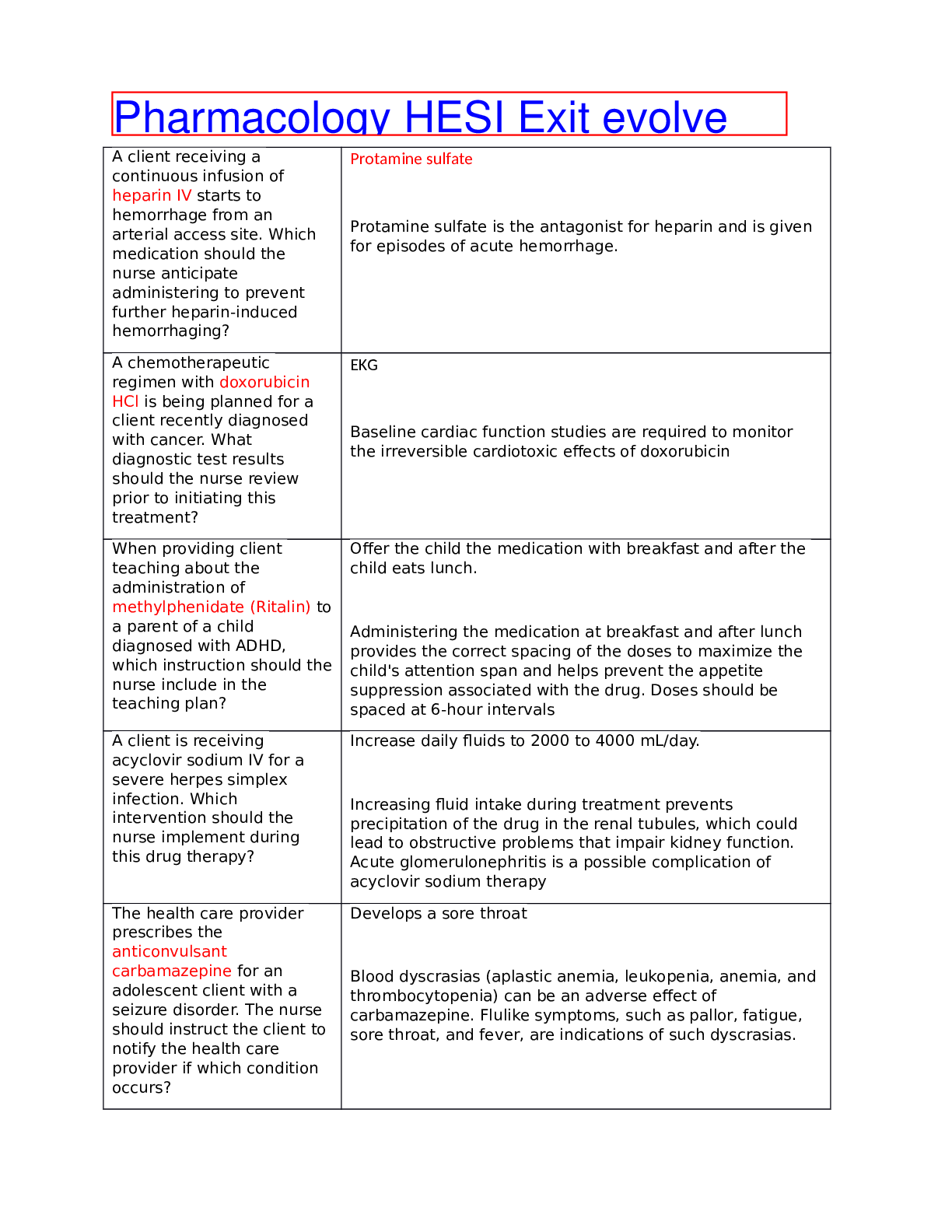
Buy this document to get the full access instantly
Instant Download Access after purchase
Buy NowInstant download
We Accept:

Reviews( 0 )
$11.50
Can't find what you want? Try our AI powered Search
Document information
Connected school, study & course
About the document
Uploaded On
Mar 26, 2021
Number of pages
27
Written in
All
Additional information
This document has been written for:
Uploaded
Mar 26, 2021
Downloads
1
Views
118



